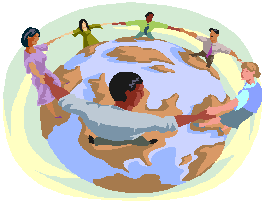5.1
Student Diversity

" Prejudice is
a burden which confuses the past, threatens the future, and renders the present
inaccessible." Maya
Angelou
Diversity is defined in many ways in United States
society. The language of diversity is characterized by terms relating to
culture, race, ethnicity, and minority status. These classification systems are
pervasive.
Yet they are often arbitrary, ambiguous, and changeable.
Culture can be used in an inclusive way to refer
to the sum of the learned characteristics of a people or an exclusive way to
describe smaller, more conceptually discrete groups of people. Race is defined
most often by physical characteristics, but sometimes also by ethnicity. The
term ethnicity refers to membership in a group with a common cultural tradition
or common national origin. Prejudice and discrimination are unpleasant and
morally unacceptable facts of life that affect teachers and students in many
ways. Minorities-defined in terms of number and power-most often suffer the
consequences.
Traditionally, learners have been defined-both in
theory and practice-in terms of their physical and psychological development,
intelligence, cognitive development, moral development, and habits of
mind.
Theorists and researchers in each of these areas have attempted to
understand the patterns of development in learners and their effect on
successful learning and growth to maturity. There is disagreement about the
meaning of most of these terms, the extent to which they relate to one another,
and their importance for teachers.
As teachers plan for instruction, they may think
about teaching and learning from the viewpoints of immigrants, language minority
or bilingual students, and males and females. Teachers also consider
exceptionalities (special abilities or disabilities) and sexual orientation of
students.
Educators who work with immigrants from around the
world try to help them understand culture in the Unites States so they might
participate successfully in society. At the same time, teachers encourage other
students to learn about immigrant cultures and morals.. Given their nations of
origin, languages, religions, values, and ethnic identities, immigrants add to
the richness that is public education in the United States.
Learners may be characterized by their facility
with the English language. If students are thought to be
limited-English-proficient, they are likely to participate in a bilingual
education program or to be immersed in English, depending on school resources
and philosophies. Students often experience difficulty maintaining their native
tongues and their family cultures.
Student gender influences teaching and learning.
The likelihood of taking certain courses, speaking up in class, being classified
as needing special help, and so forth, tend to characterize the sexes. Student
may also be viewed from one or more perspectives of exceptionality. These
include giftedness, mental retardation, hearing, visual, or orthopedic
impairments, speech and language disorders, emotional behavior disorders,
attention deficit disorder, and learning disabilities. Each exceptionality has
implications for planning, teaching, and evaluating student success.
Increasingly, schools in metropolitan areas in
particular are recognizing responsibilities to provide special services for gay
and lesbian students. These may include formal instructional programs. informal
educational activities, and health and social services.
Some individuals declare that the Holocaust never
occurred. Overt acts of racism and sexism and homophobia are carried out daily
in many communities, on college campuses, and in schools across the country.
Conflicts in urban, rural, and suburban areas often pit one ethnic or religious
or language group against another. Many of us are still very parochial, having
little or no experience with individuals from backgrounds different from our
own. We continue to depend on the stereotypes, generally negative, that emerge
from the social curriculum.
Activity 1
5.1 (label your assignment with this number on it or it will not be
graded!)
1. Suppose that you were explaining to a foreign student about the
culture in you school. How would you describe the culture of a typical
public school in our country? Include words such as diversity and cultural
pluralism. |
Vocabulary
Diversity =Differences
among people in regard to gender, race, age, ability, religion, ethnicity,
culture, language, and socioeconomic status.
Culture-The way of life common
to a group of people; includes knowledge deemed important, shared meanings,
norms, values, attitudes, ideals, and view of the world.
Cultural Pluralism- The
preservation of cultural differences among groups of people within one society .
This view is in contrast to the melting-pot theory that says that ethnic
cultures should melt into one.
Ethnic Group-Individuals within
a larger culture who share a racial or cultural identity and a set of beliefs,
values, and attitudes and who consider themselves members of a distinct croup or
subculture
 
|